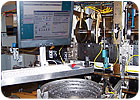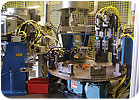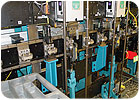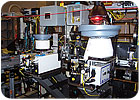
As the economy continues to improve, manufacturers will be ramping up production lines. In many industries, engineers will need to create automated assembly and test systems that integrate hardware, software and controls to produce machines that increase productivity and ensure defect-free quality.
A wide variety of components, such as leak testers, parts feeders, vision systems, sensors, electrical test systems, force gauges, ultrasonic welders, adhesive dispensers, torque testers and load cells can all be integrated into high-speed systems. As long as engineers can make a business case to justify the expense, these scalable systems can help a manufacturer achieve its quality and efficiency goals regardless of system size or structure.
As you make important decisions about capital equipment projects, sooner or later you’ll be faced with the make or buy dilemma. Manufacturing engineers typically consider building equipment internally for three reasons: cost, control and competitive edge. But, do-it-yourself projects tend to tie up personnel, facilities and development time.
The answer to the make or buy question typically depends on factors such as time constraints, the size and structure of the manufacturer and its engineering department, the assembly application and the type of machine. And, a decision to use a machine builder or systems integrator one time doesn’t mean that a company shouldn’t build a machine in-house for its next project.

Know Your Options
Manufacturing engineers have three basic options when it comes to make or buy. You can build an automated assembly system in-house; hire someone to build it for you, but use your staff to test and debug the finished product; or outsource the entire project to a third-party vendor.Selecting the right option is critical. Making the wrong choice can lead to numerous headaches and problems down the road.
A make or buy analysis can help you make the correct decision. Like any good analysis, it should begin with a comprehensive understanding of your goals, resources and costs.
First of all, do you have the necessary people on staff to build something in-house without totally disrupting your existing operations? Be honest. Check your technical ego at the door and take a long, hard look at the resources it will take to create an automated assembly system internally.
In many cases, in-house talent can do the job. However, these days, engineers rarely have extra time to tackle complex projects. Asking someone to squeeze a new project into their already hectic schedule may not be a good idea.
Also consider what you need the automated assembly system to do. For instance, do you want a machine that can log and count quantities? Inspect for correct or incorrect assembly? Ensure accurate positioning? Perform leak testing? Perform torque and force monitoring?
Timing is another important factor. Any make or buy decision must be weighed against other projects that exist within your organization. Make sure you answer questions such as: How tight is the design and production schedule? What happens if you fail to make the deadline? Can you handle the entire job turnkey with in-house resources or will you need to outsource portions of the project? Are all the components and materials you need readily available or will some require custom designs?
The depth of your experience in designing and building automated assembly systems will also impact the timing of your project. If your in-house team has extensive experience in these matters, it will take considerably less time to finish a project than if this is the first time they’re tackling it.
After you determine all those variables, figure out what the new system will cost in terms of direct project costs and business costs. A fully functional automated assembly system is worth far more than just the sum of its individual parts. Therefore, a make or buy analysis should include more than just the bill of materials cost of an automation project.
A number of other costs must be amortized if a true apples-to-apples cost comparison is to be done. These expenses fall into two important categories: direct costs and indirect costs.

Direct Costs
Direct costs include things such as salaries, raw materials, components, technical support and documentation. However, there’s a difference in the visibility of project costs vs. capital costs in most companies. While capital costs associated with automated assembly systems are transparent, calculating project cost is murkier. It rarely reflects an apples-to-apples comparison.One way to account for these costs is to list everyone who will be involved in the project. Include salaries, benefits and approximately how much time (days and hours) the project will consume. Remember to factor in the salaries of non-engineering personnel who will also be part of the project, such as technicians, safety experts and operators.
Software, hardware and raw materials are also major contributors to direct cost. But, don’t forget to add in things like maintenance, troubleshooting and service. If you are using existing equipment, remember to include a reasonable lost opportunity cost factor.
Once the automated assembly system is designed, it needs to be built. Often, companies incorrectly compare the simple component cost of an in-house system with the price of an outside vendor. This ignores a host of significant costs. For instance, it’s important to factor in relative economies of scale. Someone who does this type of work all the time will be better at it and will be able to obtain better pricing on components than a novice.
In addition, include any nonrecurring engineering costs, such as tooling. And, don’t forget to factor in a cost for assembly and set up. These costs need to be accounted for whether the job is outsourced or done in-house.
Developing an automated assembly system is a highly complex project. A fair amount of tweaking, delays, redesign and rework will be required. Problems will have to be analyzed and remedial actions taken. There are very real costs associated with these activities that must be accounted for.
Regardless of who designs and builds your system, someone must provide adequate support and documentation. The cost of these services should also be built into the project upfront.

Indirect Costs
Indirect costs associated with assembly and test systems include intangibles such as time, risk and opportunity.
Designing and building an automated assembly system presents a significant engineering challenge. This is not a part-time job. Companies that try to shoehorn it into an already overtaxed engineering department’s schedule too often pay the price in terms of project delays and outright failure.
If a project involves a mission-critical component or subassembly where Six Sigma levels of quality are not good enough, it inherently carries a commensurate amount of risk to the organization. As a result, a company weighing the risk vs. benefits of developing such a system internally rather than outsourcing it must include a risk factor as an indirect cost.
For instance, what will happen if the project is late or fails? What will be the impact on the company’s relationship and reputation with its customer? Will failure jeopardize other pending new business awards? Are there financial penalties built into the contract for missing deliveries?
Often, any savings a company was anticipating from building its automated assembly system internally quickly evaporates in the face of penalties, malfunctioning assemblies, or expedited freight and overtime charges for dealing with failed components. Generally speaking, the tighter the delivery schedule for a new system, the higher the risk.
In addition to considering time and risk, engineers need to examine opportunity cost. That is defined as benefit that has not been realized elsewhere by the organization because resources, such as people and equipment, have been allocated to a given project.
Some companies express opportunity cost as missed return on investment (ROI). You can do this by entering the normally expected revenue (or other output) generated by an engineer as a percentage of his or her cost.
For example, companies typically expect their engineers to generate three dollars in revenue for every one dollar of cost (salaries and benefits). If they do, they would be generating an ROI of 300 percent. If you pull a team of three engineers off normal assignments for a period of six months to design and develop an automated assembly system, you need to factor in an opportunity cost to your project.
The costs associated with developing an automated assembly system can be accounted for as a capital asset or as project R&D expense. If it can be classified as capital equipment, these costs can be depreciated, reducing their immediate impact on net income. Normally, to be eligible for capital depreciation, the assets must remain useful over the full period of depreciation (usually two or three years).
Ideally, assets should also be useful over a number of projects. On the other hand, if the costs of developing a system in-house are treated as project R&D expense, it will affect the company’s net income in the current financial period. This is a call that must be made by your company’s financial executives. A
To learn more about the make or buy question, click www.assemblymag.com and search for these articles:
- Do-It-Yourself Automation.
- Make or Buy Pitfalls to Avoid.
- Make vs. Buy Worksheet.